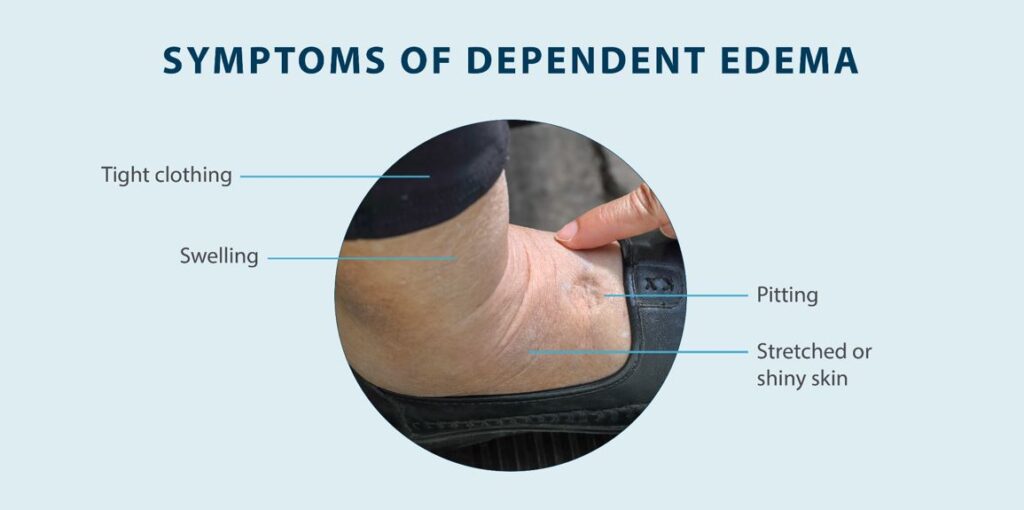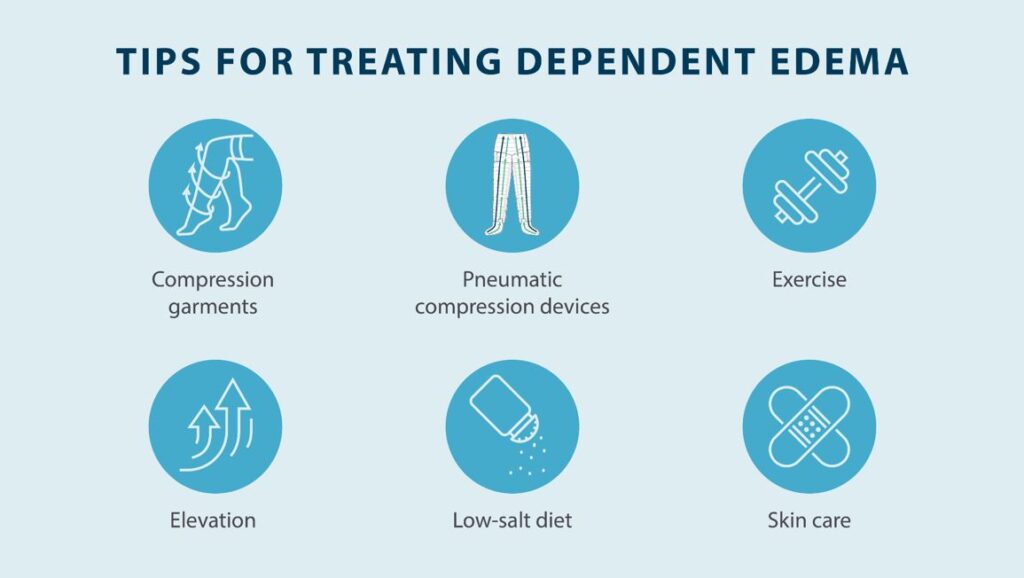Peripheral Edema
Review our guide on peripheral edema to learn about its symptoms, causes, and treatment, so you can manage your condition.
Read More

Dependent edema is swelling (edema) that affects certain parts of the body, often the legs. Gravity plays a key role in dependent edema. Getting a diagnosis and figuring out a treatment plan is an important step for people living with dependent edema. In this guide, we’ll explore dependent edema in-depth, including symptoms, causes, treatment options, and more.
What Is Edema?
What Is Dependent Edema?
What Are the Symptoms of Dependent Edema?
What Causes Dependent Edema?
How Is Dependent Edema Diagnosed?
How Do You Treat Dependent Edema?
Key Takeaways: Dependent Edema
Edema is a medical condition that’s caused by a buildup of fluid in a particular area of the body, which results in swelling. This fluid that builds up in your body is known as interstitial fluid, which is the fluid found in space around cells. The arms and legs are two areas most commonly affected by edema caused by gravity, making it difficult for fluid to flow away from those areas.
Edema can be caused by a wide range of factors, including medications, allergic reactions, medical conditions like congestive heart failure, and more. Edema occurs when the capillaries in your body leak fluid, which collects in the surrounding tissue and eventually leads to swelling if the lymphatic system is impaired or not functioning properly. Edema can also be hereditary, so you should keep an eye out for symptoms if edema runs in your family.
Dependent edema is a specific type of edema that affects areas of the body where gravity makes it easy for fluid to collect. Because dependent edema affects the parts of your body that are most affected by gravity, it typically results in a buildup of fluid in the arms, legs, and feet. Blood naturally collects in the lower parts of your body, and healthy bodies are able to pump blood from all areas of your body back to the heart. However, some individuals may have circulatory issues that affect their body’s ability to work against gravity and circulate blood back to the heart, resulting in dependent edema.1
Many people who develop dependent edema have lifestyle factors that can make this condition more likely. People who are bedbound or spend extended periods of time sitting down may develop dependent edema, and it’s also more common in people with certain medical conditions such as diabetes. If you think you may have dependent edema, you should talk to your doctor about how to treat edema. Starting treatment early on can help prevent complications resulting from dependent edema, including edema blisters and skin ulcers.
Recognizing the symptoms of dependent edema can help you get treatment sooner, which can prevent complications and reduce the severity of swelling. Here are some of the symptoms you may experience if you have dependent edema:

If you want to prevent dependent edema or determine whether you’re at risk, it’s important to understand the causes of dependent edema. While the fluid accumulation is partially a result of gravity, there are several factors that can cause dependent edema, including:2
Untreated edema can lead to numerous complications, so getting a diagnosis is an important first step. In order to diagnose dependent edema, doctors perform a physical examination, look at your medical history, and use imaging tests.
The first step is a basic physical examination, during which your doctor will check your extremities for swelling. If swelling is present in the arms or legs, your doctor may press a finger on the area to check for pitting. This physical examination helps your doctor determine whether further testing is necessary.
Because edema can be a result of other medical conditions as well as genetics, your doctor may also look at your medical history. A look at your medical history can help doctors understand whether edema runs in your family and what disease(s) you may have that puts you at risk for dependent edema.
Finally, doctors may use various types of imaging tests to make a more accurate diagnosis. Ultrasounds and pulse volume recording are two of the imaging tests that are commonly used to diagnose edema.2 Keep in mind that these tests aren’t always used to diagnose dependent edema.
From switching to a diet for edema to wearing compression garments, there are several ways you can minimize the symptoms of edema and reduce the risk of complications. Here are some common dependent edema treatment and management options:

While dependent edema is largely a result of gravity, genetics and certain medical conditions can increase your risk of developing edema. If you think you have edema, you should visit your doctor to get it diagnosed and start a treatment plan as soon as possible. Combining lifestyle changes with compression devices like the Nimbl or Flexitouch Plus from Tactile Medical can give you much-needed relief from pain and swelling. If you want relief from dependent edema, contact Tactile Medical today to learn more about the Flexitouch Plus system.
References
1. Leonard, Jayne. What Is Dependent Edema? Medical News Today. https://www.medicalnewstoday.com/articles/320986
2. MedStar Health. Dependent Edema. https://www.medstarhealth.org/services/dependent-edema
3. Trayes KP, Studdiford JS, Pickle S, Tully AS. Edema: diagnosis and management. Am Fam Physician. 2013 Jul 15;88(2):102-10. https://pubmed.ncbi.nlm.nih.gov/23939641/
Review our guide on peripheral edema to learn about its symptoms, causes, and treatment, so you can manage your condition.
Read More
Read More
Edema can affect any part of the body, but in some cases, it may only present itself in one leg. Edema in one leg is typically caused by a localized injury or lymphatic malformation that leads to swelling. Swelling in one leg can cause discomfort and affect your daily life,...
Read More
Edema can lead to several symptoms, including edema bruising. People with edema typically bruise more easily, and those bruises may be accompanied by pain. Understanding the symptoms of edema and how to manage chronic swelling can help you control your symptoms and prevent complications.
Read More
Call us at 1.800.575.1900